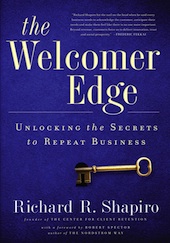Help! My main contact left, and I’m panicked!
Letter from a fan:
Dear Jeffrey, I sell copiers in NYC, and this year I finished as the number one rep in the nation. I truly believe that would not have been possible had it not been for your Little Red Book of Selling. I do have a question and would greatly appreciate your advice. Recently I have been noticing a high turnover of people (including executives) at my accounts. When this happens it’s almost like the reset button has been pressed and the replacements have no allegiance to me or my service and are usually unaware as to how hard I’ve worked to earn their company’s business. How should I conduct myself when I know there is a new person in a company I have to work with? Is there a specific process I should follow? Thank you in advance. Dan
Common problem. Uncommon answer to follow.
Loss of key contact (the person that buys from you) happens often in business, and most salespeople (not you of course) are totally unprepared for it.
There are two variations to this scenario:
1. Someone is promoted from within. If you’ve done your homework, built multiple relationships within your customer’s company, and you know the replacement,then you should be fine. If you don’t know him, you have to scramble and start over.
2. Someone was hired from the outside. This is basically a start over situation and all the answers you need are stated below.
There are 5.5 specific things you can do to prevent a total tragedy. NONE OF THEM are options.
1. Start with prevention. This is a major point of understanding: You have to ask yourself, “What would happen, what would I do, if all my prime contacts left tomorrow?” Begin to plan and act from there.
2. Then ask yourself…
3. Meet the key decision-maker outside the office AT LEAST monthly. Coffee at 7:30 AM will build the personal relationship.
4. Get known and recognized. Your weekly email about office productivity, communication, and morale will get passed around if it’s valuable – even forwarded to other professionals in other companies. And when you visit the customer, they’ll recognize you as “you’re the guy who…” smiling as they say it!
5. Build reputation across the company. Know everyone, but more important, have everyone know you – not just know you as a person, but as a person of value.
5.5 Gather video comments after every service call and delivery. Post them where anyone can view them. Your blog, YouTube channel, Facebook business page and weekly e-zine are a great start.
If all of this seems like hard work, it pales by comparison to the work you’ll have to do if you’re unprepared after the fact.
Okay, so the new person starts. Did the departing person tell you or was it a surprise? If the old person told you in advance, that’s a sign your relationship was strong. If the relationship was really strong, the departing person will put you on a preferred list of recommended vendors. If you’re blind-sided by the news, that’s a report card, too.
Let’s take worst-case scenario – new person, no history with you, bringing HIS or HER contacts, connections, and vendors:
1. Introduce yourself and offer help acclimating. Gain access.
2. Have coffee with them ASAP – get the personal relationship in gear. Share the history. Ask for their wisdom, their experience, and their goals.
3. Print your CRM history and present it to the new person so they can see your relationship and your value. (All of a sudden, CRM diligence can have an impact.)
4. Enlist others to speak on your behalf.
5. Follow ALL the ideas above.
5.5 Find the person who left. They represent the best possible NEW customer.
The key to having a new person in charge of your future sales is to be ready. It’s a simple rule of ‘the more the more.’
The more mature and solid a value-based relationship has been built with the key contact AND the rest of the company, the more likely it will be that the new person will continue doing business with you.
Reprinted with permission from Jeffrey H. Gitomer and Buy Gitomer.
About the Author


